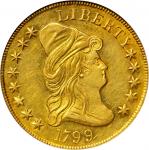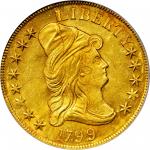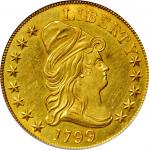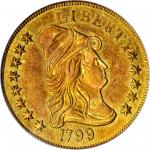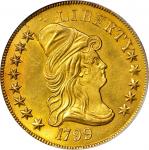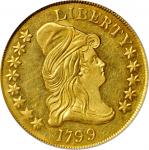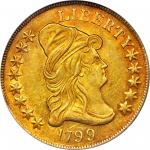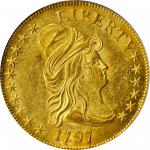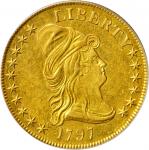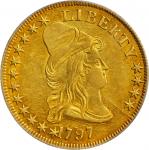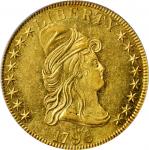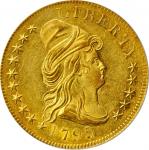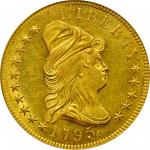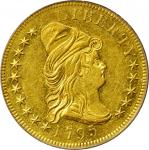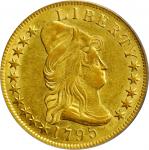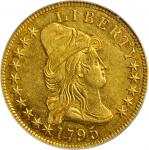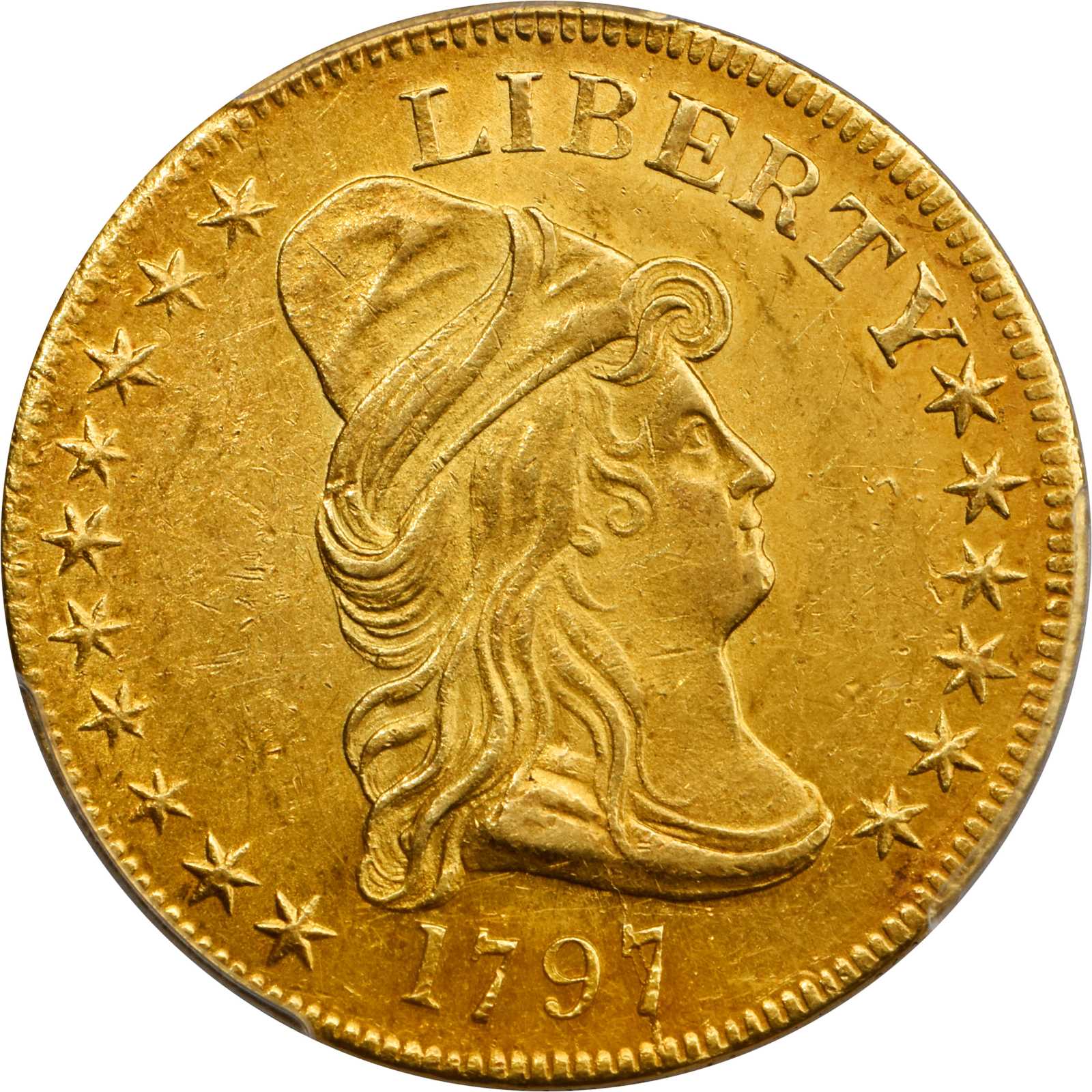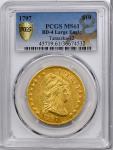1797 Capped Bust Right Eagle. Heraldic Eagle. BD-4, Taraszka-12. Rarity-4+. MS-61 (PCGS).Type and Style: Type II: Capped Bust Right, Heraldic Eagle. Style II: Head of 1795 with 16 stars arranged 10 left, six right; Reverse of 1797C with 13 stars in the field below the clouds and a long, thick neck on the eagle. The head punch is attributed to a hub prepared by Robert Scot, while the eagle punch is attributed by some to a hub prepared by John Smith Gardner.Die Variety: BD-4, Taraszka-12, Breen 2-C, HBCC-3179. Only one obverse die was used to strike all three die marriages of the 1797 Heraldic Eagle ten, and it is easily distinguished from the obverse die of the 1797 Small Eagle issue by the 10x6 star arrangement (as opposed to 12x4). The long, thick neck eagle is definitive for the reverse die of BD-4, Taraszka-12, which style does not appear on any other Capped Bust, Heraldic Eagle ten-dollar variety.Die State: BD Die State d/a. This is the only known obverse die state of this variety, and the latest known for this workhorse die that was also used to strike the 1797 BD-2 and BD-3 eagles. In this die state, there are prominent die cracks through the second digit 7 in the date. The base of that digit is joined to the border by a single prominent crack, which has now developed into a small cud. There are two cracks within that digit, the left crack continuing only to the lower serif while the right crack, with die crumble evident, continues through the top of the 7 to the base of Libertys bust. An additional die crack is present from the border through star 8, and the die has been lapped with the innermost points of several stars on the left noticeably truncated, especially star 10.The reverse die state is the earlier of two known for this variety, although it is slightly advanced from that described by Dannreuther. While the author reports this die state as having no clashing, no lapping, no cracks, the present example reveals the earliest beginnings of a crack from the border down through the left side of the letter R in AMERICA. This crack would later expand and help to define Reverse Die State b of this variety.Estimated Mintage for the Issue: The mintage for the 1797 Heraldic Eagle provided in most numismatic references is 10,940 coins, based on Walter Breens assumption that production from the new Heraldic Eagle reverse dies began on June 7, 1797 with coins bearing that date continuing to be delivered through January 30, 1798. According to Mint records, 10,940 eagles were delivered during that period. Based on a more exhaustive study of die states and emission sequences, as well as modern estimates on the number of coins extant, Dannreuther provides a broader range of 8,750 to 12,500 coins struck for the 1797 Heraldic Eagle.Estimated Mintage for the Variety: Dannreuther estimates that 3,500 to 5,000 examples were coined from the 1797 BD-4 dies.Estimated Surviving Population for the Variety: Ninety to 110 coins are believed extant in all grades (per Dannreuther).Strike: This is a well produced example with most design elements boldly to sharply defined. There is a touch of softness along the upper left obverse border and minor lack of detail to stars 1 through 10 on that side is due to the aforementioned lapping.Surfaces: Handsome deep gold patina with iridescent rose highlights evident around the peripheries. Both sides are satiny with strong luster for the assigned grade, especially on the reverse. There are no handling marks of note, and the appearance is quite nice for the MS-61 grade level.Commentary: As related above in our description for the 1797 BD-3 eagle in this collection, Anthony Taraszka concluded that all known examples of that variety were struck after the two die marriages of the 1798/7 eagle (all three varieties share the same reverse). The only known reverse die state of 1797 BD-3 is later than the reverse die states of the 1798/7 BD-1 and BD-2 varieties. While BD-4 employs a different reverse die than those three varieties, it shares its obverse with 1797 BD-3. This is significant for the obverse die in the 1797 BD-4 pairing inherits the later state from the 1797 BD-3 marriage, confirming that the former variety was also struck after the 1798/7 BD-1 and BD-2 eagles. The 1797 BD-4 variety features a unique reverse style in the early ten-dollar gold series with a long, thick neck on the eagle. Dannreuther describes this as a little known subvariety of the Large [sic] Eagle type and a transitional reverse between the tall and short neck reverses. The author believes that the long, thin neck eagle punch used for the 1797 BD-2 variety -- the first Heraldic Eagle punch prepared by John Smith Gardner -- was modified to create the long, thick neck style by the addition of extra detail to the eagles breast. BD-4 is the most readily available die marriage of the 1797 Heraldic Eagle ten, just barely edging out BD-2 for this distinction. Of course, a variety with no more than 110 coins believed extant is scarce when viewed in the wider context of U.S. numismatics. Additionally, and due to unrelenting pressure from advanced gold type collectors, high quality examples of BD-4 are rare from a market availability standpoint. The second of two 1797 BD-4 eagles acquired by Mr. Taraszka, this coin was obviously added to his collection to illustrate the early reverse die state of the variety. Worthy of another specialized early gold variety set, this lovely example is equally well suited for advanced type purposes.From the Anthony J. Taraszka Collection. Earlier from Heritages ANA Signature Auction of August 2015, lot 4415.





